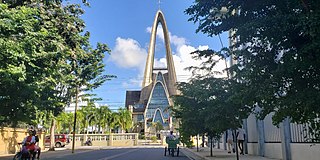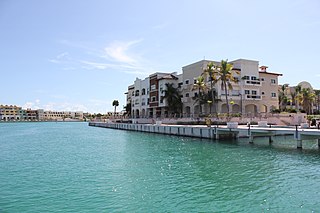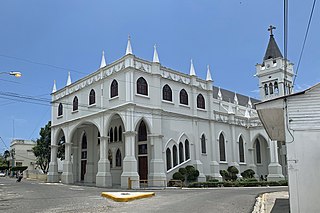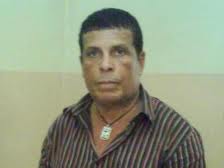
Transport in the Dominican Republic utilizes a system of roads, airports, ports, harbours, and an urban railway.

Santo Domingo, once known as Santo Domingo de Guzmán and Ciudad Trujillo, is the capital and largest city of the Dominican Republic and the largest metropolitan area in the Caribbean by population. As of 2022, the city and immediate surrounding area had a population of 1,484,789, while the total population is 2,995,211 when including Greater Santo Domingo. The city is coterminous with the boundaries of the Distrito Nacional, itself bordered on three sides by Santo Domingo Province.

Higüey, or in full Salvaleón de Higüey, is the capital city of the eastern La Altagracia Province, in the Dominican Republic, and the eighth largest city of that country. The Yuma River flows through the urban areas of Higüey.

Punta Cana is a resort town in the easternmost region of the Dominican Republic. It is part of the Veron–Punta Cana municipal district, in the Higüey municipality of La Altagracia Province. According to the 2010 census, this district had a population of 43,982 inhabitants.

La Romana is a municipality and capital of the southeastern province of La Romana, opposite Catalina Island. It is one of the 10 largest cities in the Dominican Republic with a population estimated in 2010 at 130,426 within the city limits, of whom 127,623 are urban and 2,803 are rural. The name Romana comes from the word "Bomana", a name given by Indians to what is known today as Romana River.

Cibao International Airport, also known as Santiago Airport, is located in Santiago de los Caballeros, Dominican Republic's second-largest city. It is the country's third-busiest airport by passenger traffic and aircraft movements, after Punta Cana International Airport and Las Américas International Airport. Since its inauguration, Cibao International has been projected to become one of busiest airports in terms of passenger traffic in the country. Presently it has become the third-busiest airport in the Dominican Republic, only being surpassed by the airports of Punta Cana and Santo Domingo. The airport served more than 970,000 passengers in 2006.
There are various highways and routes in the Dominican Republic. They are built and maintained by the Ministry of Public Works and Communication or MOPC. Overall the system is centered around Greater Santo Domingo, where the country's capital is located.
DR-1 is a dual carriageway highway that forms part of the five designated national highways of the Dominican Republic. DR-1 provides a fast connection between Santo Domingo, the capital, on the southern coast, and the second city Santiago and the rest of the northerly Cibao region, one of the country's main regions.
DR-2 is the second numbered national highway in the Dominican Republic. Its common name is Carretera Sánchez in honor of Francisco del Rosario Sánchez, one of the founding fathers. In the city of Santo Domingo, it is known as Autopista 30 de Mayo. The highway serves as the main connection to the southwestern region of the country. The highway's eastern terminus is located in Santo Domingo and continues on a western route through until its end in Comendador for a total length of approximately 255 kilometers. The route is mainly a two-lane roadway even though it has been recently expanded from San Cristobal to Baní and has been largely replaced by the faster DR-6 route from Santo Domingo to San Cristobal. Due to its locality and heavy traffic DR-2 has been undergoing an expansion project to make it a two-lane expressway and allow better traffic flow. DR-2 has one toll location just outside the boundaries of Greater Santo Domingo before entering the town of Haina.

DR-4 is the fourth numbered highway of the Dominican Republic. It starts from Santo Domingo eastwards to San Pedro de Macorís and then to the north to Hato Mayor del Rey and again eastwards ending in the San Rafael del Yuma.
Eastern Central University is a private university in the Dominican Republic, founded in San Pedro de Macorís on October 15, 1970, in the eastern region of the country. The university's Department of Medicine operates an important medical center located in the center of Santo Domingo. At an undergraduate level, the UCE counts with twelve academic departments: Medicine, Dentistry, Bioanalysis, Pharmaceutics, Business Sciences, Systems, Tourism, Production Sciences, Construction Sciences, Natural Resources, Law, and Social and Public Communication. The Dominican State officially recognized the institution through the Presidential Decree N°. 1205, on July 2, 1971.
The DR-7, also known as the Santo Domingo-Samana Highway or simply Samana Highway, is the newest addition to the Dominican Republic national highway system.
Central Santo Domingo or better known as Polígono Central is a term used to group several neighborhoods located in central Santo Domingo, Distrito Nacional, Dominican Republic defined as the area delineated by John F Kennedy Avenue on the north, on the west by Winston Churchill avenue, on the east by Maximo Gomez avenue, and on the south by 27 de Febrero avenue.

Rail transport in the Dominican Republic is provided by one state-owned operator and several private ones, mainly for sugar mills. There are no connections with the neighbouring Haiti.

San Pedro de Macorís is a city and municipality (municipio) in the Dominican Republic and the capital of the San Pedro de Macorís province in the east region of the country; it is among the 10 largest cities of the Dominican Republic. The city has approximately 195,000 inhabitants, when including the metro area. As a provincial capital, it houses the Universidad Central del Este university.

José Agustín Silvestre de los Santos, also known as José Silvestre and by his nickname "Gajo", was a television host of the show "La Voz de la Verdad" for Caña TV and a magazine publisher of the same title in La Romana, Dominican Republic. Silvestre was killed because of his reporting about drug trafficking and not government retribution. According to the Committee to Protect Journalists, Silvestre was the third journalist murdered in the Dominican Republic since 1992.
Juan Dolio is a small seaside community and tourist destination in the province of San Pedro de Macoris on the southern coast of the Dominican Republic on the island of Hispaniola. Juan Dolio has 2,488 inhabitants and belongs to the district municipality Guayacanes.

Tourism in the Dominican Republic is an important sector of the country's economy. More than 6 million tourists visit the Dominican Republic, making it the most popular tourist destination in the Caribbean and putting it in the top 5 overall in the Americas. The industry accounts for 11.6% of the nation's GDP and is a particularly important source of revenue in coastal areas of the country. The nation's tropical climate, white sand beaches, diverse mountainous landscape and colonial history attracts visitors from around the world.

Cotubanamá National Park is located on the lower southeastern coast of the Dominican Republic, spanning across the provinces of La Altagracia and La Romana with an area of 791.9 sq. kilometers which includes a range of dense humid and dry subtropical forests, mangroves, beaches, and caves.
















